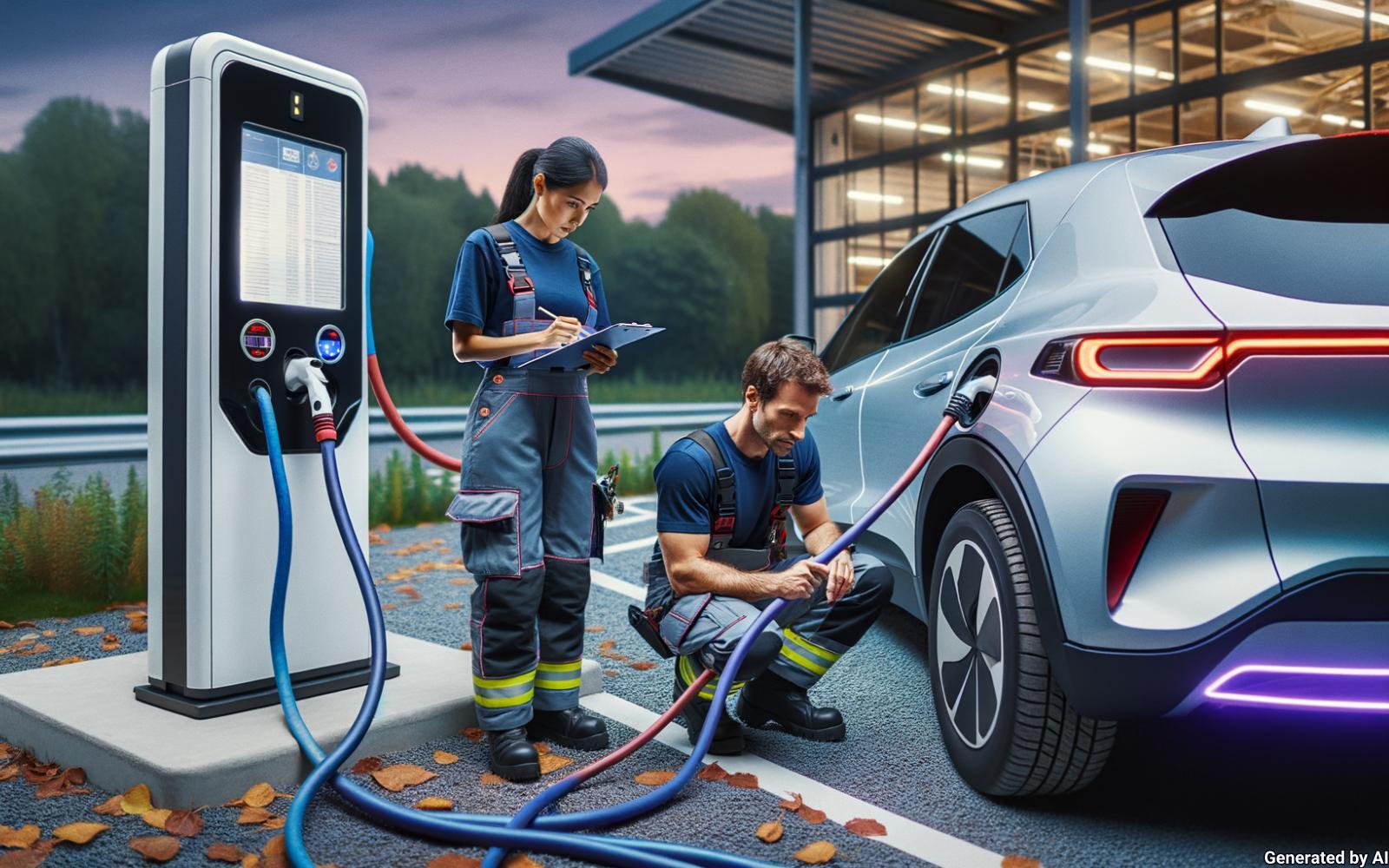EV charging station safety management – EVSE Experiences 11

Preface
EV charging station safety management
To protect the users, vehicles, and equipments, EV charging station safety management requires a checklist of precautions to be strictly followed. This article will provide you with industry experience and key points from the perspectives of
- Operational safety precautions
- Operator management
- Charging process
- User guidelines
- Equipment management
- Special weather handling

Operation Safety
Key Control
The key to the distribution box should be placed in the key box of the duty room (monitoring room). When changing shifts, the duty personnel need to hand over management authority of the key box and have the on-duty personnel count and verify the quantity and accuracy of keys.
Regular Inspection
During normal operation of the charging station, on-duty personnel should conduct regular inspections. In case of thunderstorms, overloads, or power shortages, the frequency of inspections should be increased. The entire charging process must be monitored continuously. Any abnormal equipment status should be promptly identified and handled correctly, with records kept and reports submitted to relevant superiors.
Waterlogging Prevention
Regularly inspecting and clearing the drainage facilities on roads and premises, particularly before the rainy season, can help prevent water accumulation that may saturate the charging station base or power cables. There should not be any standing water within a 2-meter radius of the charging station. Check for leaks in buildings and ensure proper drainage of sewer pipes during rainfall. After rain showers, examine basements, cable trenches, and tunnels for any accumulated water promptly draining it if necessary. Ensure sufficient ventilation when there is excessive moisture in equipment rooms.
Daily Management
Charging stations, transformer rooms, and charging rooms should be kept clean and hygienic, with cable trenches free of debris and all covers intact. Measures should be taken to prevent infestation by insects or rodents as well as theft. When entering or exiting transformer rooms, distribution rooms, or charging rooms, please remember to securely close doors and windows. Regularly inspect the sealing strips on protective nets to prevent accidents caused by small animals sneaking in. If there is any abnormality or failure in the operation of the equipment room air conditioning and cooling fans, timely maintenance or replacement should be carried out without delay.
Dangerous Goods
The entry of any flammable, explosive, corrosive, strongly electromagnetic, or radioactive materials that may pose a threat to the normal operation of the equipment is strictly prohibited at the charging station. Smoking inside the charging station is strictly prohibited as well. The use of electrical appliances unrelated to charging within the charging station is also strictly prohibited.
Core Area
Unauthorized personnel are not allowed to enter the monitoring room, charging room, distribution room, or charging area without permission. The computer used for monitoring should only be used for its intended purpose and it is prohibited to browse the internet using server devices (computers). Writing, modifying, or changing various software systems and device parameter settings on equipment in the monitoring room is strictly forbidden. Maintenance, addition/deletion/configuration changes of various software systems and addition/replacement of hardware devices must be carried out by professional manufacturers. Uninterruptible power supplies should be regularly inspected and maintained, and should not be used for any other purposes.
Communication and Emergency
When detecting obvious abnormalities in charging vehicles, it is important for charging station operators to inform customers and advise them to repair their vehicles. Unrelated personnel are strictly prohibited from plugging or unplugging the charging gun or touching any of the charging equipment. It is necessary for operators to regularly contact the power supply department proactively in order to stay updated on the operation of the power supply network. Additionally, maintaining diligent duty records, patrol records, and shift handover records is crucial. In case of emergencies, cutting off power promptly and accurately can help prevent accidents from escalating.
Operator Management
Job Responsibilities
- A charging station should have positions such as a supervisor, a safety officer, equipment maintenance personnel, monitoring staff, and chargers.
- The supervisor is the primary person responsible for the safety of the charging station and should oversee all aspects of its security and daily operations.
- The safety officer is in charge of promoting safety awareness at the charging station and ensuring compliance with regulations. They assist the supervisor in managing safety measures.
- Equipment maintenance personnel are responsible for inspecting, testing, and maintaining the charging equipment to ensure its proper functioning.
- Monitoring staff are responsible for ensuring that the charging monitoring devices and communication networks operate smoothly, enabling real-time and effective monitoring of the charging process.
- Chargers guide customers and provide them with charging services.
Skill Requirement
- The person in charge should have a comprehensive understanding of the structure of electric vehicles, be familiar with the working principles of charging facilities, proficiently grasp the operation and service standards of charging stations, as well as possess knowledge on safety and emergency handling methods.
- The safety officer should have knowledge about the construction of electric vehicles, working principles of charging equipment, mastery over charging procedures, safety knowledge, and emergency handling methods.
- The equipment maintenance personnel should understand the working principles of charging equipment, basic knowledge about power batteries and electric vehicle structures. They should also be skilled in operating procedures specific to their position including equipment testing, fault diagnosis, and troubleshooting.
- The monitoring personnel should have an understanding of the electrochemical performance of power batteries and basic knowledge regarding their applications. They must also be adept at using monitoring systems.
- The charger operator should possess basic knowledge about electric vehicle batteries while being well-versed in electrical vehicle charging safety practices along with operational protocols specific to their role as well as emergency handling methods.
Charging Process
Preparation Before Charging
- After the charging pile is powered on and self-checked, the system enters the charging interface. The status indicator of the charging machine should be able to light up normally, and the display interface of the charging machine should be able to operate without any fault display. The cooling fan of the charging machine should run normally.
- When a vehicle enters the charging area, it should be parked in a position where the cable plug can reach. The car key should be removed and kept by a dedicated person, and all doors must be locked with low-voltage power switch turned off to ensure that during the charging process, there will not be anyone performing vehicle maintenance or any other operation unrelated to charging.
- Charging operators should wear insulated gloves for their work, and when air humidity is high they also need to wear insulated shoes.
- Confirm that high-voltage manual quick breakers are connected properly.
- Check whether both sides of charger gun and socket are intact,tightened securely,dry,and dust-free.
- Check that there is no damage on charge cables before use.
Connecting Charging Gun
- Remove the charging gun from the fixed rack of the charging station, holding it with one hand while holding the charging cable with the other hand. Pull on the charging cable to move it, but avoid pulling on the charging gun.
- Apply even force to insert the charging gun into the vehicle’s charging socket and ensure that its locking latch engages with the socket groove. The mechanical button on the charging gun should pop up, ensuring full contact between the charger plug and vehicle socket.
Charging
- Choose the charging mode to initiate the charging process, and the charger will perform a charging handshake before entering the monitoring interface for charging status.
- Once charging begins, ensure that all charging data is normal and monitor the operational status of the charger closely. If any interruptions or abnormalities occur, immediately stop the process and notify maintenance personnel for assistance; unauthorized intervention or judgment is strictly prohibited.
- In case of abnormal noises inside the charger, unusual current or voltage displays, strange odors or smoke generation within the machine, anomalous LCD screen displays, or anomalies in various signal indicator lights during operation, promptly cease charging and cut off power supply by switching off AC main switch to prevent further damage to components.
- If battery voltage rises rapidly when approaching saturation level during a charge cycle, immediately halt it and provide timely feedback to relevant technical personnel for their attention and resolution.
- No personnel is allowed to stay in the vehicle during the charging process. It is strictly prohibited to open the doors, start the vehicle’s power, move the charging equipment, or engage in any other activities.
- Pulling, tugging, shaking, knocking or unplugging the charging gun during the charging process is strictly forbidden. The operation of the charging gun should only be performed after automatic termination of charging or manual interruption.
- Do not cover the charger during the charging process to avoid excessive equipment temperature.
- If any abnormalities occur at the vehicle end during charging, immediately press down on the emergency stop button of the charger and then turn off AC main switch in distribution room.
- It is strictly prohibited to touch bare wire parts inside of charger during acharging process.
Finish Charging
- In non-emergency situations, it is not allowed to use the emergency stop button to halt the charging process. You can either wait for the charging process to end automatically or click on the “Stop Charging” button on the charger’s control screen. In case of any abnormal circumstances, please press the “Emergency Stop” button and disconnect the power supply of the charger from the distribution box. Then report to maintenance personnel for troubleshooting any faults with the charger.
- Before removing the charging gun from its socket, please press the unlock button first and then gently pull it out with even force to avoid damaging the socket latch. Any rough handling is strictly prohibited.
- When moving the charging gun and cable, hold onto both with one hand; pulling only on the cable is not allowed. Afterwards, neatly hang up and clean both ends of the charging cable on a cable holder, inserting its plug into a slot without randomly entangling or placing it haphazardly.
- Before driving away, operators at charging stations should confirm that the charging has been terminated and ensure there is physical separation between the charging equipment and electric vehicles.
User Guidelines
Enter
When the vehicle enters the charging station, the driver should obey the instructions of the charging station staff, strictly follow the designated driving route, and maintain a vehicle speed within a range of 5KM/H. The vehicle should be parked in designated areas (fully charged and waiting for charging), without obstructing access pathways. Each vehicle is prohibited from occupying multiple charging spaces. Unauthorized vehicles are not allowed to enter the charging area, and no vehicles are permitted to park in emergency evacuation routes.
Behaviors
- The entering driver must strictly comply with the safety management regulations of the charging station and must not cause any damage to any facilities inside the station.
- The entering driver must strictly adhere to the fire safety regulations of the charging station; smoking is prohibited on site, and it is strictly forbidden for drivers to bring vehicles carrying flammable, explosive, highly toxic, corrosive, radioactive or strong electromagnetic hazardous materials into the charging station.
- The entering vehicles and drivers should keep the site clean and it is prohibited to litter or dispose of waste materials randomly within the premises.
- Repairing or testing brakes in vehicles is strictly prohibited inside the charging station; no one is allowed to learn vehicle driving within its premises.
- If any dangerous situations occur during charging, promptly contact the operator of the charging station and cut off the power supply using the emergency button. If necessary, call for emergency assistance.
Departure
- After the charging is completed and before driving, the driver should confirm that the charging has stopped and ensure physical separation between the charging equipment and the electric vehicle.
- Unauthorized individuals are strictly forbidden from moving vehicles at charging stations.
- Leave promptly from the charging station when it is safe to do so in order to avoid interfering with others’charging or causing traffic congestion.
Finish Charging
- In non-emergency situations, it is not allowed to use the emergency stop button to halt the charging process. You can either wait for the charging process to end automatically or click on the “Stop Charging” button on the charger’s control screen. In case of any abnormal circumstances, please press the “Emergency Stop” button and disconnect the power supply of the charger from the distribution box. Then report to maintenance personnel for troubleshooting any faults with the charger.
- Before removing the charging gun from its socket, please press the unlock button first and then gently pull it out with even force to avoid damaging the socket latch. Any rough handling is strictly prohibited.
- When moving the charging gun and cable, hold onto both with one hand; pulling only on the cable is not allowed. Afterwards, neatly hang up and clean both ends of the charging cable on a cable holder, inserting its plug into a slot without randomly entangling or placing it haphazardly.
- Before driving away, operators at charging stations should confirm that the charging has been terminated and ensure there is physical separation between the charging equipment and electric vehicles.
Equipment Management
- The charging machine should be protected from strong vibrations or continuous exposure to high temperatures and humidity.
- Flammable and explosive materials, corrosive chemicals, electromagnetic objects, and metal conductive materials are prohibited from being placed around the equipment, and clutter must not be stacked.
- Tea cups, kettles, containers with liquids, mobile phones, keys and other items should not be placed on equipment cabinets or tables.
- Storage is not allowed inside equipment cabinets.
- Wires and cables in the computer room or monitoring room cannot be randomly pulled or pasted with files or images unrelated to the equipment.
- Heavy objects or sharp-edged metal objects are not allowed to press on cable wires.
- It is strictly forbidden to use a charging station when there are defects such as cracks, wear and tear, breakage of charging guns or cables, exposed charging cables and so on.
- It is not allowed to use charging stations or plugs that are currently undergoing maintenance or repair for charging operations.
- During equipment operation, cleaning of equipment cabinets and surfaces, as well as any maintenance tasks such as tightening screws, replacing parts, moving electrical cables, and accessing control panels, are strictly prohibited.
- Power interruption (switching off) during equipment operation (charging process) should only occur in exceptional circumstances.
- The time interval between two power-on cycles should not be less than 20 seconds (disconnecting the input power).
- Using sharp objects or rough handling on the charger’s touch screen is strictly prohibited; please avoid applying excessive force when operating the buttons.
- Scratching or scraping the charger’s casing with hard objects is strictly prohibited; do not use acidic liquids or abrasive cleaners to wipe any part of the charger to prevent damage to its housing.
- It is strictly prohibited to have condensation and severe mold presence inside the charging equipment. Correction: Condensation and severe mold presence inside the charging equipment are strictly prohibited.
- Non-professionals are strictly forbidden from disassembling, repairing, or modifying the charging facilities. Correction: Disassembling, repairing, or modifying the charging facilities is strictly forbidden for non-professionals.
- In case of failure in the charging equipment that cannot be promptly repaired, warning signs and fault prompts must be displayed. Correction: If there is a failure in the charging equipment that cannot be promptly repaired, warning signs and fault prompts must be displayed.
- During thunderstorms or grounding faults, attention should be paid to potential step voltages. Operators should wear insulated shoes and keep a safe distance from the grounding point. Correction: During thunderstorms or grounding faults, operators should pay attention to potential step voltages and ensure they wear insulated shoes while maintaining a safe distance from the grounding point.
Special Weather Handling
- Before severe weather conditions such as typhoons, heavy rain, and strong thunderstorms arrive, protective measures must be taken for charging facilities. For charging stations without rain shelters, charging operations should be suspended during thunderstorms, rain or snowfall, and the power supply to the equipment and AC main power in the distribution room should be turned off. For charging stations with rain shelters, charging operations should be temporarily halted during severe typhoons, intense lightning storms, frequent lightning strikes or any other hazardous weather conditions that may pose a safety risk. The power supply of the equipment and AC main power in the distribution room should also be shut down.
- Charging operations are prohibited when there is a risk of rain or snow entering the charging interface.
- During rainy days, avoid exposing the plug pins of the charging gun and electric vehicle socket to rainfall to prevent water from coming into contact with the charging interface and causing metal corrosion or electrical leakage.
- Opening equipment doors is prohibited on rainy days; after rainfall stops ensure that there is no accumulated water (especially inside equipment doors) before opening them.
- After rainfall stops, make sure there is no accumulated water at the cable connections or copper bars of the charging pile before initiating a charge; also ensure that there is no water inside the charging sockets.The charging machine should be protected from strong vibrations or continuous exposure to high temperatures and humidity.
- If there is high humidity, connect the charging machine to the power source first and wait for 30 minutes for the cooling fan to operate before starting the charging process.
- In damp weather, make sure that both the charging gun head and socket are dry; otherwise, do not charge.
- If there is leakage during rainy days, maintain a safe distance fromthecharging equipmentand immediately turn offtheAC main switch inthedistribution room.


0 Comments